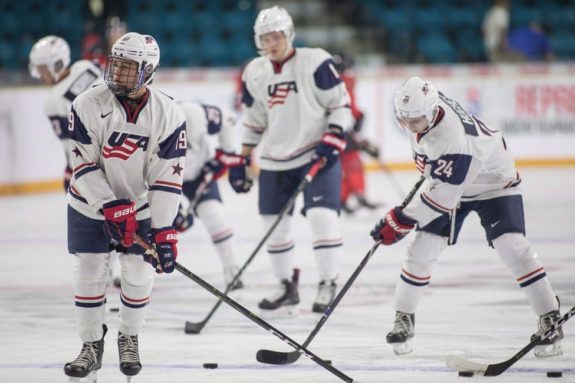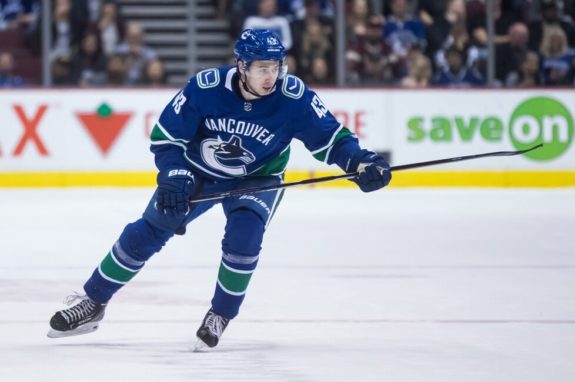There’s little doubt, if any, that Quinn Hughes will be in the Vancouver Canucks opening night lineup in roughly three weeks time. The Canucks haven’t had a rookie forward on the same level as Elias Pettersson in a long time, but it’s been even longer since they had a defenceman of the same calibre as Hughes. Fans were treated to watching Pettersson compete and saw him change the course of the Canucks rebuild right before their very eyes. Now it’s time for Quinn Hughes to completely revitalize the Canucks’ defence corps.
We’ve heard countless times before that the Canucks haven’t had a defenceman with Hughes’ level of talent ever before, and that’s hard to argue with. His superior skating abilities along with his top-notch hockey IQ and elusiveness make him a unique defender who is built for the modern-day NHL. This modern style defender is a contrast to the style of big and tall defenders such as Erik Gudbranson, who Canucks’ general manager Jim Benning was once extremely high on.

With a league that is quickly transitioning to speed and skill over size and physical play; Hughes is exactly the type of defencemen the young Canucks, who are now built on speed and skill, needed. Hughes will be able to create odd-man rushes, more efficient breakouts, and a much more lethal power play for a Canucks team that finished 25th in total goals scored last year.
Quinn’s younger brother, Jack, was the first overall pick at the 2019 NHL Draft, which was held in Vancouver. Jack is a complete player who can do it all, but some analysts still believe that Quinn has a better shot at the Calder Trophy than Jack does. How can this be? It’s arguably much more difficult to win the Calder Trophy as a defenceman, and with his brother, who is a center, shattering records everywhere he goes, how can anyone possibly think Quinn has a better shot at capturing the NHL’s Rookie of the Year award than Jack does?
Hughes’ Challenge Ahead
It’s simple, and it all has to do with the opportunity Hughes will be given to thrive under head coach Travis Green. Whether you like it or not, the Calder is almost always awarded to the player who puts up a ton of points. It’s rare that someone is winning the Calder based solely on their defensive play.
Related: Canucks’ 3 Areas of Improvement for 2019-20
The last two defencemen to win the Calder were Aaron Ekblad in 2014-15, and one of the newest Canucks, Tyler Myers, who won the award in 2009-10 with the Buffalo Sabres. Ekblad put up 12 goals and 27 assists through 81 games while Myers scored 11 goals and picked up 37 assists. We know he can put up points at the NHL level, but the question for Quinn will be how many points can he point up, and how many will be enough to beat out the many talented forwards in this season’s rookie class?

Ekblad benefited from a split decision, as both Mark Stone and Johnny Gaudreau put up 64 points each in their rookie seasons. Ekblad received 73.06 percent of the vote, while Stone and Gaudreau got 68.66 and 65.35 percent, respectively. For Myers, it was a much more unanimous decision. The runner ups for the Calder that year were 25-year-old Jimmy Howard and Matt Duchene. Myers and Duchene were both 19, but Myers managed to get just seven points less than Duchene, who was a forward. Myers received 89.24 percent of the vote while Howard and Duchene got 58.94 and 57.20 percent.
Hughes got five games in at the end of last season after his NCAA season came to a close. In those five games, coach Green put Hughes in situations where he could succeed. In the games he played last season, Hughes had 85.7 percent offensive zone starts and 14.3 percent defensive zone starts. In order to be successful, Green needs to utilize Hughes in a way that is best for both the Canucks and the player; in this case, that means keeping the majority of Hughes’ zone starts to offensive zone starts.
Hughes talked about the benefit of those five games, and how that experience helped him prepare for the season ahead:
It’s nice to gauge yourself a bit and just kind of know you can play there (the NHL), and not go through the summer wondering what it’s going to be like. For me, I think that helped a lot.
-Quinn Hughes
Equipped with more knowledge of what he needs to do to be successful at the NHL level, Hughes will not only change the way the Canucks enter the zone, but will also provide a whole new threat on the power play for teams to pay attention to. This will naturally give players like Brock Boeser and Elias Pettersson, two players that opposing penalty killers hone in on, more time and space. A power-play quarterback with Hughes’ abilities is exactly what the doctor ordered for these new-look Canucks.

Hughes’ ability to wheel the puck up the ice and quickly transition the play the other way for his team will be key to the Canucks if they expect to be more competitive going forward. Since joining the Canucks on March 29th, Hughes led all Vancouver defencemen in successful carry-outs with 29. Alex Edler and Troy Stecher had the second most with 12. If that doesn’t tell you how dramatically different Hughes’ play style is than any defencemen the Canucks have had in recent memory, I don’t know what will.
Related: 2019-20 Canucks Have the Makings of a Contender
With rookies like his own brother and 2019 second overall pick, Kaapo Kakko likely in the running, winning the Calder will certainly be a tall task for Quinn to accomplish. Nonetheless, no matter where Hughes finishes in Calder trophy voting, he will change the way that fans in this market think of defence. Gone are the days of the dump and chase from the red line, rather, fans will become accustomed to seeing agile defencemen elude the opposition as they burst into the zone with a head full of steam. Leading the charge for years to come on the Canucks, will be Quinn Hughes.